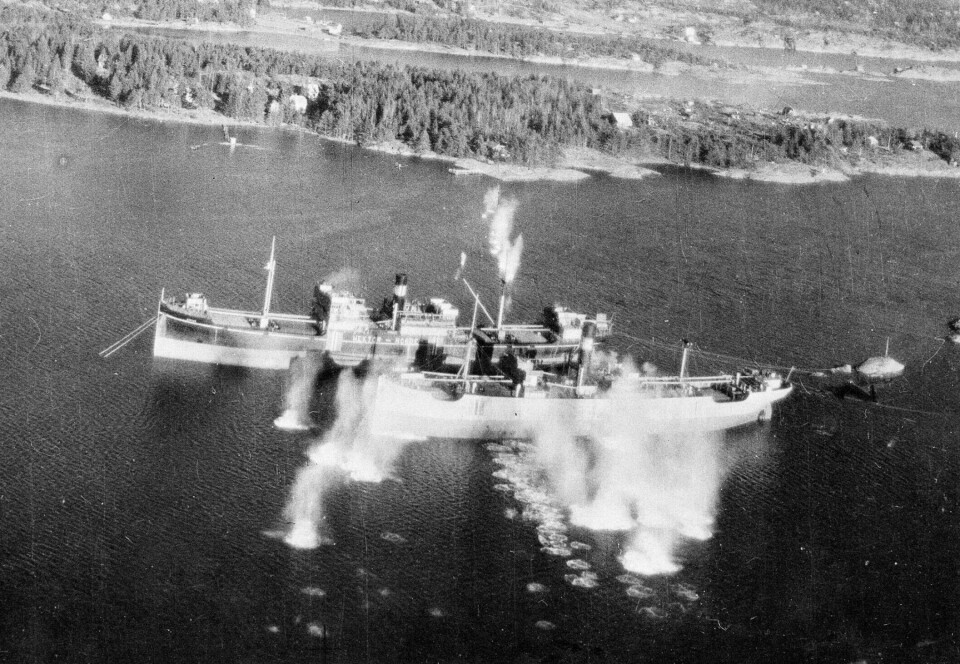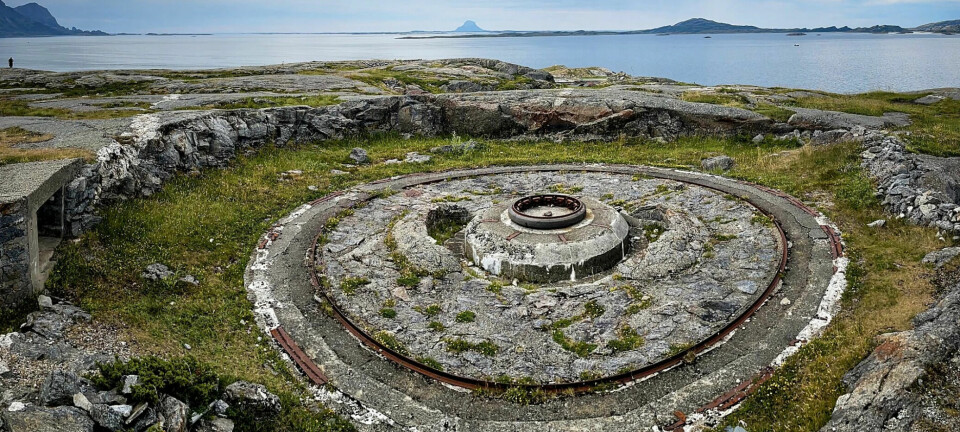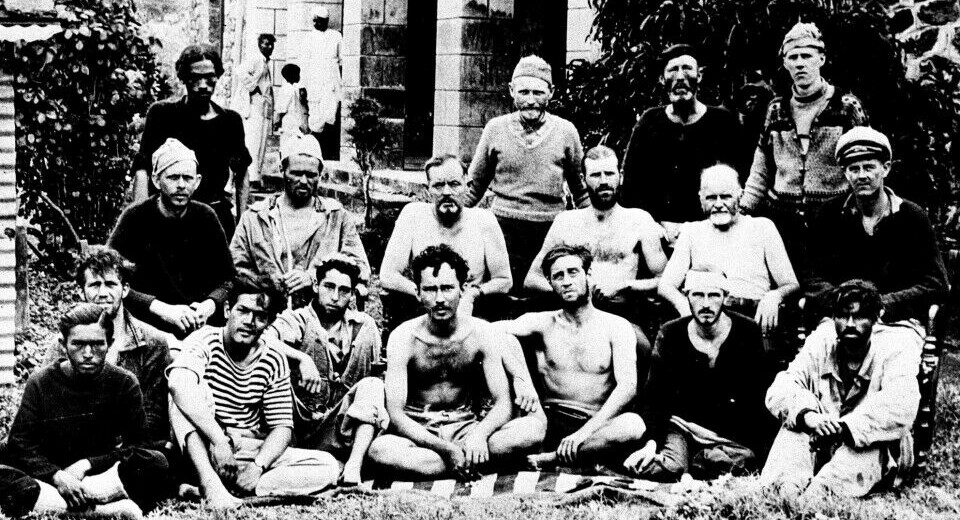
Maritime pilots were forced to work for the Nazi occupiers and bombed by British planes
Some pilots did the job unwillingly, others tried to escape, and some worked for the resistance movement. But there were also pilots who volunteered.
When Norway was occupied by Nazi Germany in 1940, thousands of ferries, boats, and ships were docked in ports or operating along the coast. They came under German command.
The occupiers needed someone to pilot these ships safely up and down the winding Norwegian coast.
That was the job of the pilots, of which there were 800 at the outbreak of war.
In the first days after the occupation, these pilots did not know what to do. Some were public servants, others were private traders. Who decided what they should do now? Should they to work for the Germans? What was more important – to work as a pilot and navigate the ship, crew, and passengers safely to their destination – or resistance against the occupiers?
The pilots chose different paths. Some under duress, others voluntarily.
When the war ended, some of them suffered for the choices they made.
Those who chose the job
Ole Sigvart Wiksnes was a pilot from Kopervik in southwestern Norway. He was a state pilot, meaning he was employed by the Norwegian government to pilot ships in and out of Norwegian waters.
A few days after the occupation, Wiksnes and the 60 other pilots in Kopervik were told that if they did not report to work, they would be punished.
So when the new German harbour master came to him, Wiksnes had made up his mind.
He chose to follow the order to carry out his work, even though it meant working for the Germans. The alternative was to flee.
Many of the pilots struggled with substance abuse and mental health problems after the war, in the same way as the war sailors.
Historian Anne Tove Austbø at the Stavanger Maritime Museum has written about the pilots during the war in the book Norsk Loshistorie (Norwegian Pilot History). As part of her research, she spoke to Wiksnes' son, among others.
“The pilots were subjected to massive coercion. For Ole Sigvart Wiksnes, it was also a matter of duty, even though he really had no choice. Key shipping personnel were ordered to work,” she tells sciencenorway.no.
Ship traffic was vital for transporting goods along the coast. Northern Norway was completely dependent on food deliveries.
Wiksnes was primarily a pilot. His job was to safely deliver supplies. "We have to howl with the wolves we're among," he told his sons.
Bombed by the Allies
But the pilots did not only work with cargo transport. They also had to work on German military ships and Norwegian civilian ships that transported soldiers and weapons.
“Most of the pilots stayed in the job, either out of duty or coercion. And the job became more dangerous,” says Austbø.
British planes were after them. They bombed both military and civilian ships. During the war years, more than 200 ships in the home fleet were sunk, many of them due to Allied attacks by aircraft, submarines, or mines.
The coast was blacked out, lighthouses were extinguished, and routes were changed. It became much more difficult to navigate.
For the Norwegian sailors who worked on ships outside Norway, it was the Germans who sent bombs and torpedoes to sink them. For those working in the home fleet, it was the Allies who caused sudden death and injury.

In September 1943, British planes attacked a Norwegian coastal express ship, the Sanct Svithun. The British suspected that there were German soldiers on board, but they had already disembarked. The passengers were civilians. As the ship sank, the captain and the pilot managed to run it aground to save as many people as possible, Austbø writes. A total of 47 people died, while 76 were rescued.
“Many of the pilots struggled with substance abuse and mental health problems after the war, in the same way as the war sailors,” Austbø explains.
Those who did not want to work for the occupiers
There were many pilots who tried to avoid working for the Germans.
Some of them quit their jobs as pilots. This sometimes went well, but most were ordered to continue piloting ships, often with pressure from the Security Police.
Some called in sick. This was not always accepted.
Austbø describes several cases where pilots were summoned to the Gestapo and forwarded to German military doctors.
In Bergen, 70 pilots on sick leave had to appear for a compulsory examination. Ten of them were sent straight home, while four had to start working immediately. The others were told to report to the hospital the following week for a medical examination.
In her book on Norwegian pilot history, Austbø describes how some pilots made attempts to escape.
Olav Olsen Nordvaagen from Honningsvåg tried to take a leave of absence. He had been given time off to help in the family's fish shop. The mayor submitted a new leave application on Nordvaagen's behalf. Either he had to be granted leave, or the shop had to close. The application was rejected.
Harald L. Berg from Tranøy tried another approach. He referred to international law and the Hague Conventions and refused to pilot German military ships. In a letter to the German-controlled Norwegian Maritime Authority, he wrote that an occupied population could not be incorporated into the service of the occupying state. He was, however, willing to pilot civilian ships that supplied the Norwegian civilian population with goods. Berg did not succeed, and continued to work on all types of ships.
Those who resisted
The Germans had control over ship traffic, but had to rely on Norwegian pilots.
The pilot has great authority on board. The captain is responsible for the ship, cargo, and crew, while the pilot provides advice on safe navigation during the voyage. During the war, pilots lost their authority and ability to act. The Germans were suspicious and feared sabotage.
In 1940, the ship DS Skogheim was on its way to Germany, loaded with iron ore. Along the way, it ran aground and sank. The sinking was explained by the fact that the pilot, Nils Sheldrup, had suddenly fallen ill. That explanation was not accepted, and the pilot was charged with sabotage.
The pilots knew which ships went where, and some of them passed this information on to the resistance movement and the Allies.
Tønnes Hansen was one of them. He was forced to work as a pilot and decided to pass on as much information as possible to the resistance movement. It got him into some difficult situations.

He informed the Allies about ships where friends and colleagues were on board, thereby exposing them to possible bombing.
He also reported the position of a ship on which he himself was aboard.
Hansen told local newspaper Dalane Tidende in 1954, reproduced in Austbø’s book: "And when my turn came, there was no choice: I had to do it. Yes, the planes came, and the ships came, and they did take a cursory look at us, but submarines in the waters meant that they targeted them instead of us. If that hadn't happened, we would have been blown to bits – as expected."
Those who volunteered
Eventually, there was a shortage of pilots, despite coercion and duty.
Around 60 pilots had died in shipwrecks, according to figures from 1944. Others had been injured or had frayed nerves after piloting ships in dangerous situations. Some had managed to evade service.
The Germans began to train their own, but there were also Norwegians who volunteered.
“The pilots earned good money, and many needed work. Some probably also had sympathy for the occupying power," says Austbø.
Most viewed
The requirements for pilot competence were lowered. Sailors and fishermen who were familiar with the coast sought jobs as pilots or were commissioned. Once they started, they were not allowed to quit.
The settlement after the war
The pilots had been well paid during the war. Some of them worked voluntarily. Not everyone tried to escape.
This had consequences for the pilots when the war ended.
“After the war, everyone who had been in German service was suspected,” says Austbø.
The pilots sorted this out themselves. Commander Captain Arnulf L'Orsa was given the job of investigating all 600 pilots.
The distinction was made between those who already worked as pilots in 1940, and those who started working as pilots during the war.
Some lost their license to practice the profession and were branded as Quisling pilots.
“After they weeded out those who had voluntarily worked for the Germans and made good money from it, they moved on,” she says.
The work of documenting the pilots' history during World War II has not been easy.
Forgotten, hidden away, and not among the war sailors
“It has been difficult to find good sources. The documents were scattered across various archives, much has been lost, and the main characters have died,” says Austbø.
She has spoken with the descendants about their fathers' choices and work.
“The pilots are not mentioned much in the history of the war, so I wanted to find out more both in the archives and about the people. They faced incredible ethical choices and dramatic daily lives,” says Austbø.
Everyone who sailed on Norwegian ships during World War II has been listed in the War Sailor Register. There, the pilots who were on ships that sailed to Allied ports in 1940 are mentioned.
But this was not the case for the pilots and sailors who were on ships in Norwegian ports when the war broke out, and who were forced to work for the occupiers.
Now, they too will be included.
“We have not yet conducted a systematic registration of the seafarers in the home fleet 1940-45. We will start this work in 2024,” says Ole Jørgen Søndbø Abrahamsen. He is a historian and responsible for Krigsseilerregisteret (the War Sailor Register).
This work will take many years.
“Then the pilots who worked along the coast in Norway during the Second World War will be registered, as long as they piloted a ship flying the Norwegian flag. This also applies to ships that were under German command during the war,” he says.
Ships that sailed only under the German flag will not be included in the register.
———
Translated by Nancy Bazilchuk
Read the Norwegian version of this article on forskning.no






































